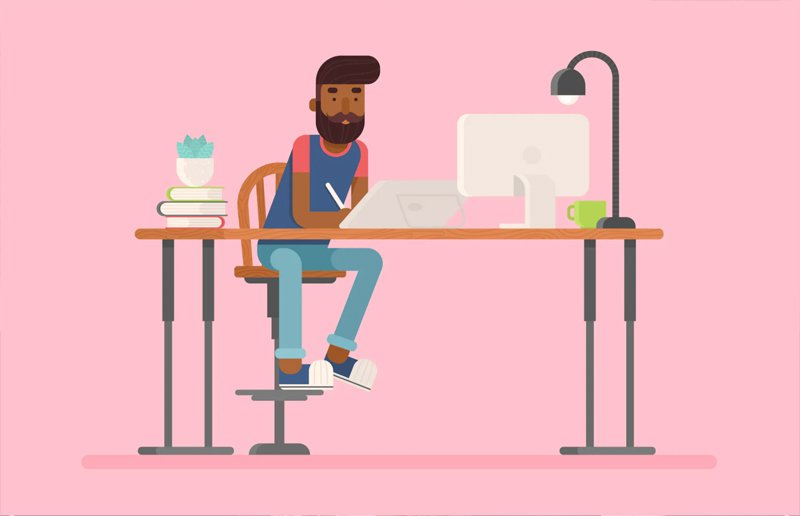Nine things to watch out for as a freelance illustrator, from those who know
Whatever creative career you enter, there's always a steep learning curve. And a lot of the time, you learn from your mistakes as you go. If you go into illustration, though, you're most likely to spend most of your career as a freelance. And that means some of your mistakes will cost you money and may even lead you into financial hardship.
Thankfully, countless freelance illustrators have gone before you, and it's possible to learn from their mistakes rather than making them yourself. To help you out, we asked the Creative Boom community on Twitter to share their top tips on the things to really watch out for as an illustrator. We share the best of them below.

1. Pay close attention to contracts
Working as a freelance illustrator, you soon learn one thing. Just because you think you agreed on something in a friendly chat on the phone with a client doesn't mean this will be reflected in the contract you're asked to sign. So check everything very carefully before doing so.
"Watch out for copyright grabs!" warns Kendyll Hillegas, an illustrator working in editorial, advertising and packaging. "Even if a client has told you what the work will be used for, make sure you read the whole contract before you sign. It's not uncommon to find 'all rights' language hidden in there."
And if you see something you don't like, say so. "It's totally fine to push back on contract terms," says designer and illustrator Taaryn Brench. "Most good clients will be happy to discuss changing them. However, when you get the amended contract back, read through ALL of it again in case they've changed something elsewhere. It's been known to happen!"
And here's one more tip from luxury fashion and lifestyle illustrator Anna Wijnands. "Include the delivery deadlines for reference images in your contract," she advises. "Because if you're depending on the images they send you, and they don't do it on time, you can get really stressed trying to still finish before the deadline."
2. Join the AOI
If you're working in the UK, then contract concerns are one of many good reasons to join the Association of Illustrators. If you're worried about something you've been asked to sign, you can send it to them to look over.
"Also, if you're a student, it's massively helpful to take advantage of the student membership at the AOI, which is much cheaper than the standard one," says illustrator and painter Loulou Elliott. "There's a lot of information provided, and personal advice is readily available. Plus, you have a ready-made, established network you can tap into."
Speaking of the AOI, here's a tip directly from them. "Illustrators are increasingly being asked to sign away their copyright by clients, and agreeing to these terms sets the expectation that other illustrators will do the same," says communications coordinator Marianna Madriz. "If you get this kind of request, don’t worry: you don’t have to accept it! Every contract can be negotiated, and ultimately a licence benefits all parties involved."
Even if you're not a member, the AOI has some useful public resources on its website, which are helpful for anyone starting out as a freelance, including How to licence illustration, What is a Contract?, What is a Copyright Assignment? and Pricing Basics.
3. Keep track of usage

As we explained in our article on pricing your work, usage terms are central to licensing an illustration to a client. But in reality, clients often step over the line that's been agreed in the contract, so you do have to keep an eye open and push back where necessary.
"Watch out for your work being used beyond what was agreed, "cautions Niki Groom, an award-winning illustrator working in fashion, beauty and lifestyle. "If you spot that happening, then just go politely to the client, explain it wasn't included in the license, and give them a price for extended usage."
Another thing to watch for, adds Tim, is clients asking for the original files. "While that might sound innocent, in practice, it often means they want to edit it themselves and change it. And that is a breach of 'moral rights', i.e. the right you have of integrity in your work and reputation. Put simply; an edit might make your work look bad."
4. Avoid project creep
Here's another way a project can commonly veer away from what was originally agreed on paper. "One of the big ones for me is project creep when you agree on the specifics of the job, but it gradually grows beyond the original scope," says illustrator, designer and photographer Tim Easley.
Designer and illustrator Savanna Rawson has had the same experience. "For example, if a full-page illustration is changed to two half-page illustrations, it's not the same price: that's two concepts and probably twice as much work."
Sometimes your workload increases, not so much by project creep but generally disorganisation at the client end. One danger sign of that, says illustrator and designer Andy Carolan, is "more than one person client-side having the final say in the design process. It can lead to conflict and confusion for all."
If the brief isn't clear about what the client wants, says illustrator and graphic designer Denzel' BLLACK LINE' Kessie, "ask as many questions as possible till the clients' needs become apparent. It will reduce the number of revisions you need to do. These questions may also give the client more clarity on what they want."
And if things aren't going perfectly, don't blame the client; instead, try to empathise with them. "You can't necessarily expect your client to have the vocabulary to give constructive feedback," points out illustrator and visualiser Matt Richards. "Art direction is quite a skill, so be prepared to lead that conversation if your client isn't able to."
Immersing yourself in the industry can help keep you up to date: like a self-education that will eventually develop your own supportive community. Be as involved as you can, and that will pay off.

5. Pay attention to cashflow
One of the weird things about freelance life is that if you don't plan ahead properly, you can be working like a Trojan and still short of cash to pay your rent or bills. "In early stages of freelance, I took on a lot of work without a contract," recalls illustrator and animator Connie Noble. "This meant some places paid three months after publication, so I sometimes didn't get paid for four to five months after creating an illustration."
Connie also advises avoiding clients who don't give a budget upfront when asked. "If you want to hire someone, have a price in mind, and you'll quickly learn if that's too low," she says. "It's ridiculous trying to determine a price based on zero info."
6. Don't work for free
When you're short of work, it's tempting to work for free. But this is usually a bad idea. "Instead, spend that time doing personal work for your portfolio – the kind of work you want to be doing – and then send it to the people you would like to work with," advises freelance illustrator Dionne Kitching.
Taaryn agrees that personal projects are a great way to spend any downtime. "Nearly every single one of mine has lead to paid commercial work," she says. "They're extremely useful in dictating the work you want to do, as clients are not mind readers!"
While people often ask you to work for free in return for "exposure", a more subtle way that illustrators are persuaded to work for free is through competitions. "I can't think of another industry that's so bombarded with competitions!" says Niki. "You wouldn't enter a competition as a plumber, doctor or accountant, so if you're new to illustration, don't feel like you should get involved with these. Many are ways for brands to source loads of great ideas and create a social media buzz with no financial outlay. Very often, they do a rights grab too, and even the winner's fee doesn't reflect industry standards."
7. Don't take on too much
When you start as a freelance illustrator, your biggest fear is not having enough work to sustain you. Even if you become successful, that fear never quite leaves you, which can lead to you overloading yourself with work unnecessarily.
"Learning how to counterbalance the irregularity of freelance work means not saying yes to everything if you're already busy," says author and illustrator Harry Woodgate. "Make sure you take quiet periods as opportunities to rest if you can." Editorial illustrator Amy Lauren adds: "Don't reply to anything on weekends."

Work-life balance is partly about the amount of work you take on, but also the type of work. "Be very selective about the commissions you take on," recommends illustrator and painter Louise Gouet. "Make sure it feels right and takes your work in the direction you want. If it doesn't, your time is better spent working on personal work that lights you up!"
8. Get involved in the community
Many people become illustrators because they like spending time alone, and that's fine. But don't discount the value that getting involved in the illustrator community can bring.
"Immersing yourself in the industry can help keep you up to date: kind of like a self-education that will eventually develop your own supportive community," says Loulou. "Sign up for creative newsletters. Check sites like the Dots, Creativelive and Underpinned for opportunities and free lectures. Follow and interact with artists you like and companies you'd like to work with. Offer to meet with whoever you'd like to over coffee. Collaborate, and make opportunities for yourself rather than waiting for them. Be as involved as you can, and that will pay off."

9. Don't panic!
We'll end with possibly the most important piece of advice we can give freelance illustrators: don't panic. "Watch out for clients who bamboozle you with urgency or importance," says Niki. "You don't have to reply to them immediately. Speak to the AOI or other illustrators if you need help, rather than agreeing to something you can't deliver or don't quite understand."
Illustrator and pattern designer Lauren Marina concurs. "Don't feel under pressure to quote a project on an initial call," she says. "Take the time to work out a great price, and come back to the client in good time with a formal quote in an email."
Source: Creativeboom.com
